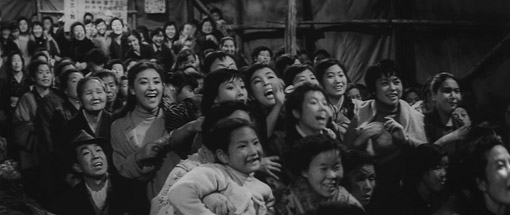| |
"Many years ago, I was friendly with a well-known scriptwriter, who used to work with Ozu Yasujiro, and was staying with him at his holiday house. I was working on one of my scripts – it was a serious work – and he stood up from the fireplace, which was in the centre of the room, and came over and began reading the script over my shoulder. I thought this was a rather horrible and nasty thing to do, but then he said, 'Oh you are still writing about beggars and all those dropouts from the mainstream of society'. |
| |
"I didn't like this comment and it really started to get on my nerves because I didn't think this was the correct way to characterise these people, the ones you call oppressed. Even though some of the things these people say might sound ridiculous, their lives and the experiences they pass through are true-life issues and their comments are from the heart. They are human beings and even though they might be at the bottom of society, what they say is true. And if you are not moved by what they say and do in my films, then it is really my fault, not theirs, because it means that my films haven't accurately reflected their true feelings." |
|
Imamura Shohei, interviewed on the
World Socialist Web Site, September 2000 * |
A few years ago I had a good friend who worked at the Japan Academy of Moving Images (formerly the Yokohama Academy of Visual Arts), with whom I sadly lost touch after he, for very personal reasons, choose to shut down communication with almost everyone he knew. It's a friendship that allowed me to visit the school and meet a number of its esteemed lecturers, many of whom were respected filmmakers in their own right. Perhaps unsurprisingly, I never did get to meet the school's rightly revered co-founder, Imamura Shohei.
At the time of my visit, almost none of Imamura's films were available on DVD in the UK, in spite of the widespread acclaim that had greeted the cinema release of his 1997 Palme D'Or winner, The Eel [Unagi]. The extent of this shortcoming was really brought home when my friend sent me the programme for a comprehensive retrospective of the director's work being organised by the Academy (a scan of which you can access in the right-hand sidebar). The list of films being shown, complete with brief synopses and associated screenings, ran for two A4 pages, which left me wondering why, given Imamura's reputation, it was so hard to get to see any of them.
In the US at least, Criterion have attempted to address this imbalance, while in the UK the task has been taken up by the fine people at Eureka's Masters of Cinema label, who after a solid DVD release (and an almost identical Blu-ray) of Imamura's superb 1979 serial killer drama Vengeance is Mine, blew us all out of the water with their stunning Blu-ray of one of the director's most extraordinary and offbeat works, the 1968 Profound Desires of the Gods. And now they've delivered a dual format release containing Imamura's 1958 debut feature, Stolen Desire [Nusumareta yokujo], and what is widely regarded as his 1961 breakthrough feature, Pigs & Battleships [Buta to gunkan].
Stolen Desire was Imamura's first feature as director, and frankly there's nothing in the film itself to indicate this. Everything on screen suggests the work of a more experienced filmmaker – it's all there in the quality and range of the performances, in the handling of the large ensemble cast and a sizeable collection of extras, in the technical assurance and the coherent but sometimes exuberant storytelling, and in the confidence to spend ninety minutes focussed more on character than the mechanics of plot development.

Adapted from the story Tent gekijô [Tent Theatre] by Kon Tōkō and borrowing elements from Ozu's 1934 A Story of Floating Weeds [Ukikusa monogatari], Stolen Desire is set in what used to be known in Japan as a 'beggar's theatre', a company of travelling players who made their living by moving from town to town, putting on shows for entertainment starved locals. Key members of this particular troupe are owner and travelling theatre veteran Taminosuke, his daughters Chidori and Chigusa, young director Kunida, and leading men Kanji, Eizaburo, Eisuke and the older Tomihachi.
As the film opens, things are not going particularly well for the company. They're at the tail end of a less than successful run in Osaka, a city where alternative and superior entertainment was probably not hard to find even back in the late 50s. Their shows are an uneven mix of the serious and the salacious, with dancing girls used to pull in an audience who are then subjected to some comically overacted drama (which a Japanese friend told me was known as "downtown kabuki"). By this point their shows are poorly attended and prone to on-stage argumentative collapse.
The following morning they are evicted to make way for more lucrative entertainment and head out to the small farming community of Kawachi, which generates such a level of local excitement that you wonder why they bothered with Osaka in the first place. For the good people of Kawachi, the arrival of the troupe is akin to a circus run by film stars rolling into town – the girls giggle and fawn over the leading men, while the seemingly sex-starved male population ogle the women and sneak into their camp at night to cop a glimpse of them bathing. Others look to profit from the company's presence, from the brush factory manager who barters with the actors over the rental of his tent, to the two old women who sell home-made Coca-Cola made from mint soda mixed with Chinese medicine.
With the story well under way at the film's start, information about characters and relationships unfolds on the move. University drop-out Kunida is passionate about his art and is continually pestering Taminosuke to allow him to try a new version of one of their plays, despite being offered a television job by a former fellow student. His decision to stay is good news for Chigusa, who has a real thing for the young director, but he has the hots for her older sister Chidori, who unfortunately for him is married to fellow actor Eizaburo. The lecherous Kanji chases anything in a kimono and sparks in-fighting and local ire when he attempts to seduce local girl Misako on the pretext of auditioning her to join the show. Elderly Tomihachi, meanwhile, is targeted by Coca-Cola woman Okin, who plans to marry him and cash in on his life insurance when he dies before her.

It's an incident-busy tale told with the energy and bustle of a 1930s Hollywood backstage musical and is every bit as entertaining, with comedic elements that range from amusing one-liners to an exaggeration of reality that borders on farce. The champions of this are the lecherous male locals, who scuttle about in the dark to catch a peek of the bathing women like they're auditioning for pantomime. It's all great fun and was clearly never designed to be anything more, though that shouldn't stop film scholars from reading between the gags and identifying the elements – and there are plenty here to find – that define this as an Imamura rather than a Nikkatsu film.
As a studio crowd-pleaser, the film boasts all of the requisite ingredients for a Nikkatsu B-movie entertainment. What makes it and its then young director stand out from the crowd is that every one of these components – lecherous males, semi-naked females, troubled romance, adulterous affairs, broad comedy, etc. – feels organic to the story and never shoehorned in to please the studio execs. Even the upbeat ending proves something of double-edged emotional sword – like Hawkeye's departure from the mobile hospital at the end of Robert Altman's M*A*S*H, one couple's escape to a new and perhaps better life is tinged with sadness for the effect it will have on the collective dynamic.
Pigs & Battleships (and what self-respecting film fan wouldn't be intrigued by such a title?) is a film that genuinely bounds onto the screen, pulling us down from the rooftops into the gaudy, neon-lit red-light district of post-war Yokosuka, a region that functions as a sleaze magnet for the personnel of the local American naval base. The audacious manner in which business is conducted is energetically established in the opening few minutes, as the camera roves a main street in which white-uniformed sailors almost outnumber the locals, who buzz around the Americans like thirsty mosquitoes in over-enthusiastic attempts to fleece them of their pay. One of the most active of these predatory insects is Kinta (Hiroyuki Nagato), who in the accompanying booklet Tony Rayns brilliantly describes as "a walking attention-deficit disorder, a man whose mind flits from one hare-brained impulse to the next and has the expressions and mannerisms to match." Seriously, how can I top that? A hyperactive hustler and wannabe gangster, his method of soliciting customers for the whorehouse he works for is to grab the hat from a passing sailor and run to the brothel, then shove his pursuer towards the first available girl. It appears to work, at least until the shore patrol turn up to bust up the party.

A portrait unfolds of a semi-symbiotic relationship based on mutual exploitation, in which just about anything that can be sold to the American servicemen will be put up for sale by anyone looking to make a quick buck. Central to this thriving black economy are the local chinpira gang (a kind of low-level wannabe yakuza) run by hypochondriac hard man Himori (Nakahara Sanae), a man Kinta works for and is desperate to please. Kinta scorns the very idea of a regular job and dreams of rising through the criminal ranks, despite the objections of his girlfriend Haruko (an excellent Jitsuko Yoshimura, also memorable as the sex-starved wife in Onibaba), whose mother is planning to sell her to the highest American bidder. The gang's latest wheeze involves breeding and fattening pigs to sell to the Americans as pork, a process that relies on procuring the necessary scraps to use as feed, which puts them in bed with wealthy Chinese opportunists Wang and Chen. Kinta is placed in charge of the piggery, but as his involvement with the gang deepens and his ambitions grow, his relationship with the determined Haruko is pushed to breaking point.
For a non-Japanese audience, following the fine details of Kinta's dodgy dealings and gangland associations can prove a bit of a challenge. Deals are done without expositional dialogue and characters arrive and depart on the fly, notably gang veteran Harukoma, who after a brief introduction reappears not long after as a straw-wrapped corpse to be transported for disposal. It's a crime that comes back to haunt the gang when his body is discovered by Kinta's father, an honest woodchip seller who despairs at his son's gangland associations, and later becomes the subject of jet-black humour when one Harukoma's false teeth turns up in a suckling pig meal, the result of one gang member's labour-saving brainwave for body disposal.
The choice of pigs for their metaphoric as well as their economic value is announced in the title and carried through in the portrait of Yokosuka's red-light district, a human farmyard populated by shameless opportunists, who pimp out their womenfolk to American servicemen who are only too happy to buy what's on offer. In this cycle of exploitation, all men really are the pigs of feminist legend. It's a concept taken to an memorable extreme in the now famous climax, where the animals run loose in the Yokosuka streets and chase their human equivalents into cramped back alleys, a porcine metaphor that peaks when the two are crushed together in an extraordinary facial melding of man and beast.

But as the story progresses, it's the fractious relationship between Kinta and Haruko that becomes the film's emotional core. Haruko disapproves of Kinta's criminal lifestyle, which she repeatedly pesters him to abandon for a regular job, something Kinta dismisses until he is too deeply embroiled to ever make the switch. Partly as a result, it's the fiery Haruko who, despite falling victim to her anger at Kinta and the corrupting presence of the American base, ultimately emerges as the only one with the strength and determination to escape the cycle of exploitation that defines her home town.
Very much a product of the Japanese New Wave (which took its Japanese name, Nuberu bagu, directly from the French Novelle Vague), the film bristles with the sort of energy and irreverence that American cinema would not fully embrace until the late 60s. Even the opening music, where the first few notes of The Star Spangled Banner drift into a blend of Souza, parade ground drums and bar-room jazz, plays like an up-front announcement of the film's playful intentions. The result is bold and energetic delight and everything a great breakthrough film deserves to be: it tells a complex, multi-stranded story with wit, intelligence and narrative drive; it takes a freewheeling approach to the standard yakuza drama and layers it with socio-political comment and jet-black comedy; it is darkly surreal at the very point when studio film lore states it should be triumphant; and it shows an already accomplished director experimenting with form and technique and bringing a new wave sensibility to a studio production. In his accompanying essay, Tony Rayns suggest that for all its considerable merits, Pigs & Battleships is still a little too tidy to be considered a pure Imamura work, but it's still very much the film that first identified Imamura as the auteur he was soon to become, and it remains one of the most inventive energetic and enjoyable works of the then still emerging Japanese New Wave.
Although there are two features included in this dual format package, Pigs & Battleships is the headlined film and it's not hard to see why. The screen grabs here really don't do it justice, as on a large plasma screen the Blu-ray transfer really does look lovely, with a sometimes beautifully balanced and pleasingly non-aggressive contrast range, rich grey tones, and an often eye-popping level of picture detail, particularly in the wider street scenes or close-ups involving clothing or faces. The contrast does soften and the black levels fade when the light levels drop, but this does help to preserve picture information that would otherwise be lost. The image has also been impressively cleaned up and restored, and there are almost no signs of any damage or dirt. Those without a Blu-ray player should not feel short-changed, as the DVD transfer is similarly strong, but a side-by-side comparison reveals a much higher level of detail on the Blu-ray.

The Blu-ray transfer on Stolen Desire, while also very good, is not quite as polished as that of the later film. The contrast range is a little more variable, being soft in darker scenes and harsher in sunlight, but for the most part a very reasonable balance is struck. The detail is not as crisp here as it is on Pigs & Battleships – indeed, a side-by-side comparison with the DVD shows very little difference between that and the Blu-ray transfer. There is also a little more damage and dust visible here, but for the most part the print is clean, and although it more readily betrays its age than its companion, it's still a pleasing transfer for a low budget film of this vintage.

The DTS-HD Master Audio 2.0 mono tracks on both films are in very good shape for their age, being free of noise or damage, with Stolen Desire only betraying only a small trace of background hiss. The dynamic range of both is inevitably narrow by today's standards, with the usual treble bias on dialogue and music.
Nothing on the discs themselves, but given that you get two feature films for the price of one, you could argue that Stolen Desire is an extra feature in itself, and a superb one at that. What we do have is the always welcome Masters of Cinema Booklet, the bulk of which consists of a typically excellent overview of both films and their production by Tony Rayns. The usual credits, poster reproductions and production stills for the films are also included.
I won't even start on the reasons for the ludicrously late arrival of this review, but if you still haven't picked up this excellent double feature from one of the most rightly revered figures in Japanese cinema then add it to your shopping list immediately. Two great films, one decently and one beautifully transfered, and both on DVD and Blu-ray in the same package for price of a good many single film mainstream Blu-ray releases. Highly recommended.
* http://www.wsws.org/articles/2000/sep2000/imam-s19.shtml
|